Comprehensive Report on Diverted Profit Tax in Australia
VerifiedAdded on 2021/04/24
|8
|2715
|50
Report
AI Summary
This report provides a comprehensive analysis of the Diverted Profit Tax (DPT) in Australia. It begins by outlining the context of the enactment of the DPT, explaining the problem of profit diversion by multinational corporations and the Base Erosion and Profit Shifting (BEPS) strategies employed to reduce tax liabilities. The report then delves into the proposed operation of the DPT, detailing its applicability to significant global entities and the assessment process managed by the Australian Taxation Office (ATO). The evaluation of the tax utilizes the canons of taxation, assessing its performance against principles of equality, certainty, efficiency, and simplicity. The report also considers the DPT as a necessary response to tax avoidance, comparing it with similar measures in other countries, like the UK, and highlighting the complexities for taxpayers. The analysis concludes by summarizing the impact of the DPT in the Australian context, and highlighting the need for a more streamlined approach.
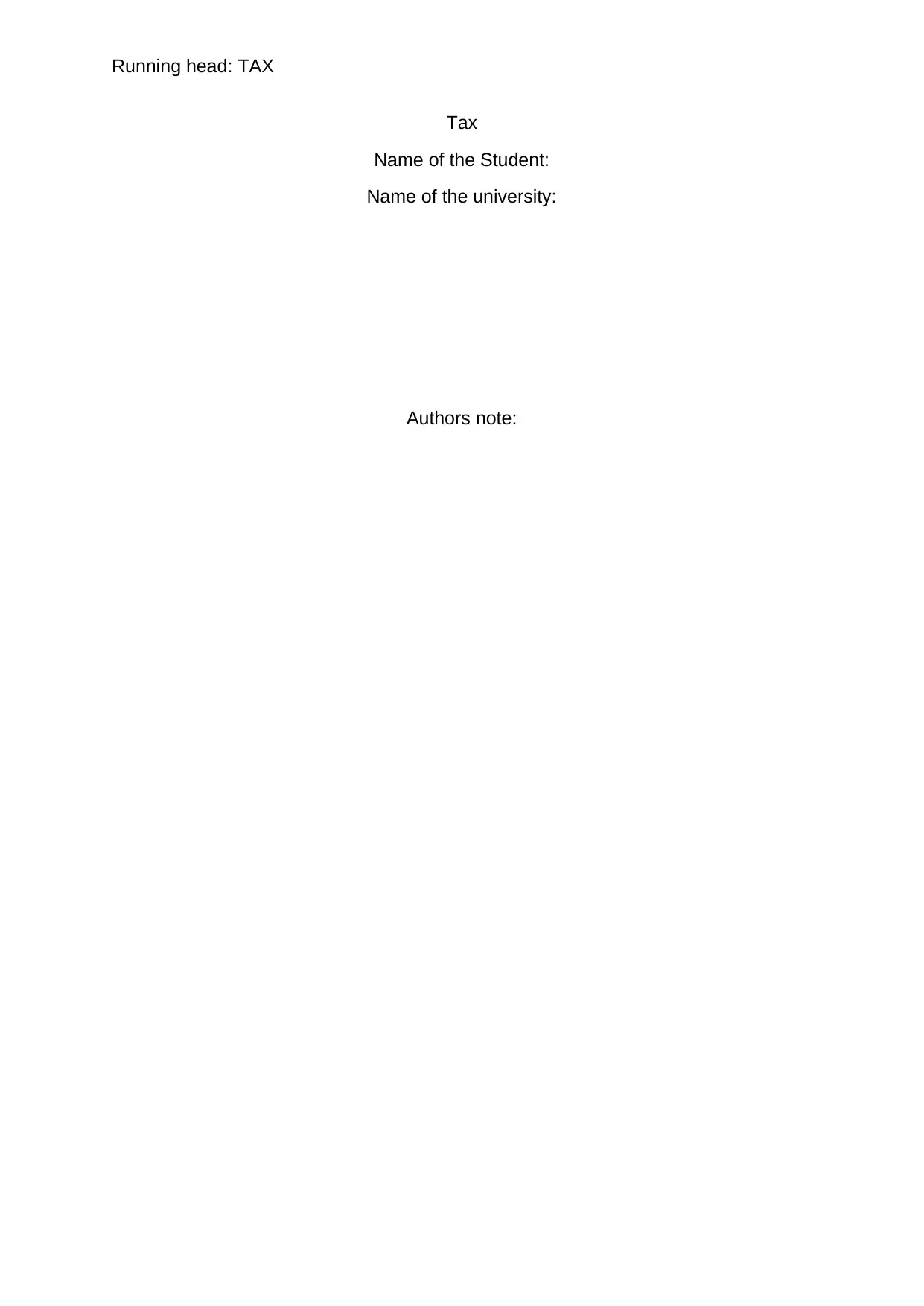
Running head: TAX
Tax
Name of the Student:
Name of the university:
Authors note:
Tax
Name of the Student:
Name of the university:
Authors note:
Paraphrase This Document
Need a fresh take? Get an instant paraphrase of this document with our AI Paraphraser
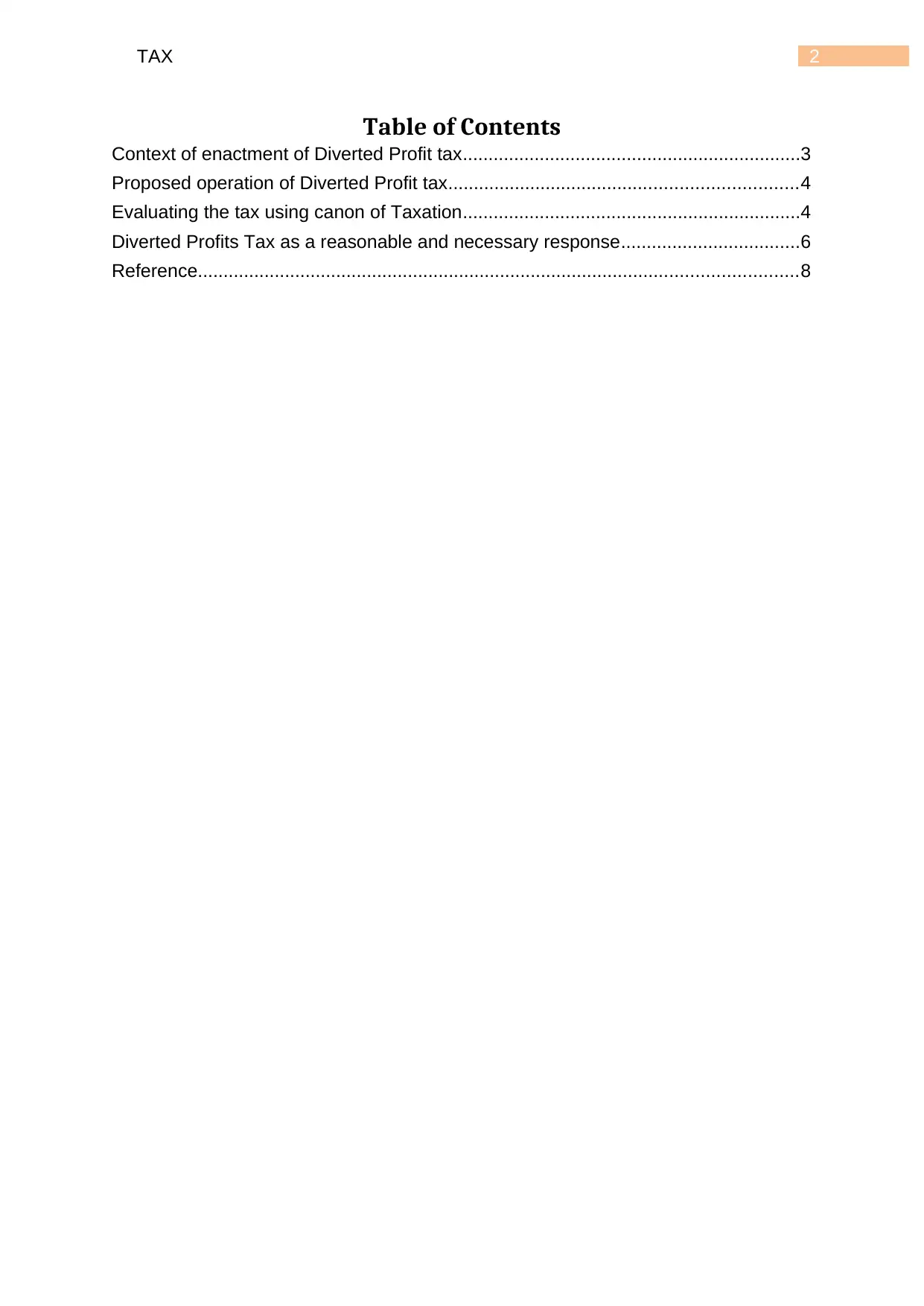
2TAX
Table of Contents
Context of enactment of Diverted Profit tax..................................................................3
Proposed operation of Diverted Profit tax....................................................................4
Evaluating the tax using canon of Taxation..................................................................4
Diverted Profits Tax as a reasonable and necessary response...................................6
Reference.....................................................................................................................8
Table of Contents
Context of enactment of Diverted Profit tax..................................................................3
Proposed operation of Diverted Profit tax....................................................................4
Evaluating the tax using canon of Taxation..................................................................4
Diverted Profits Tax as a reasonable and necessary response...................................6
Reference.....................................................................................................................8
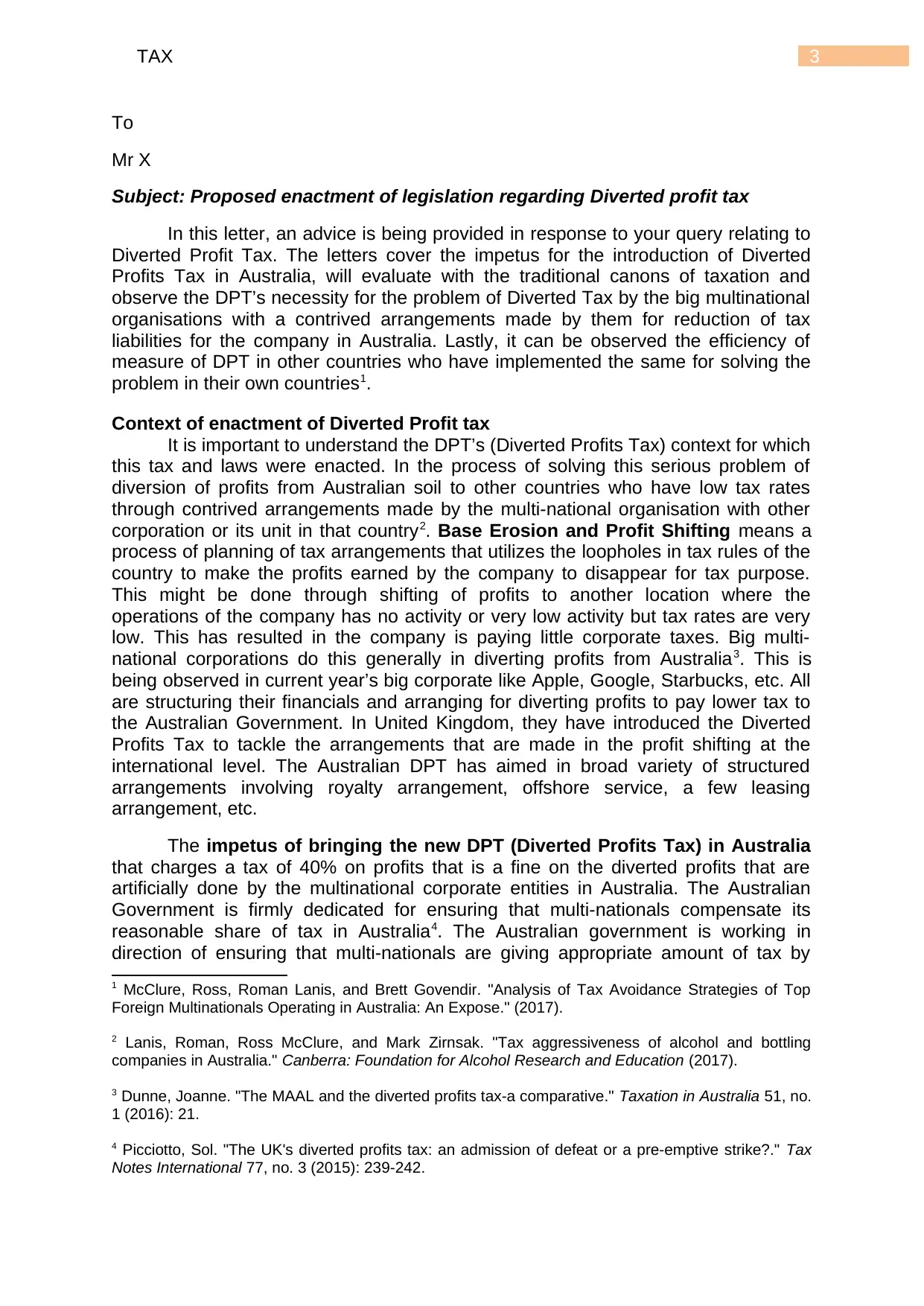
3TAX
To
Mr X
Subject: Proposed enactment of legislation regarding Diverted profit tax
In this letter, an advice is being provided in response to your query relating to
Diverted Profit Tax. The letters cover the impetus for the introduction of Diverted
Profits Tax in Australia, will evaluate with the traditional canons of taxation and
observe the DPT’s necessity for the problem of Diverted Tax by the big multinational
organisations with a contrived arrangements made by them for reduction of tax
liabilities for the company in Australia. Lastly, it can be observed the efficiency of
measure of DPT in other countries who have implemented the same for solving the
problem in their own countries1.
Context of enactment of Diverted Profit tax
It is important to understand the DPT’s (Diverted Profits Tax) context for which
this tax and laws were enacted. In the process of solving this serious problem of
diversion of profits from Australian soil to other countries who have low tax rates
through contrived arrangements made by the multi-national organisation with other
corporation or its unit in that country2. Base Erosion and Profit Shifting means a
process of planning of tax arrangements that utilizes the loopholes in tax rules of the
country to make the profits earned by the company to disappear for tax purpose.
This might be done through shifting of profits to another location where the
operations of the company has no activity or very low activity but tax rates are very
low. This has resulted in the company is paying little corporate taxes. Big multi-
national corporations do this generally in diverting profits from Australia3. This is
being observed in current year’s big corporate like Apple, Google, Starbucks, etc. All
are structuring their financials and arranging for diverting profits to pay lower tax to
the Australian Government. In United Kingdom, they have introduced the Diverted
Profits Tax to tackle the arrangements that are made in the profit shifting at the
international level. The Australian DPT has aimed in broad variety of structured
arrangements involving royalty arrangement, offshore service, a few leasing
arrangement, etc.
The impetus of bringing the new DPT (Diverted Profits Tax) in Australia
that charges a tax of 40% on profits that is a fine on the diverted profits that are
artificially done by the multinational corporate entities in Australia. The Australian
Government is firmly dedicated for ensuring that multi-nationals compensate its
reasonable share of tax in Australia4. The Australian government is working in
direction of ensuring that multi-nationals are giving appropriate amount of tax by
1 McClure, Ross, Roman Lanis, and Brett Govendir. "Analysis of Tax Avoidance Strategies of Top
Foreign Multinationals Operating in Australia: An Expose." (2017).
2 Lanis, Roman, Ross McClure, and Mark Zirnsak. "Tax aggressiveness of alcohol and bottling
companies in Australia." Canberra: Foundation for Alcohol Research and Education (2017).
3 Dunne, Joanne. "The MAAL and the diverted profits tax-a comparative." Taxation in Australia 51, no.
1 (2016): 21.
4 Picciotto, Sol. "The UK's diverted profits tax: an admission of defeat or a pre-emptive strike?." Tax
Notes International 77, no. 3 (2015): 239-242.
To
Mr X
Subject: Proposed enactment of legislation regarding Diverted profit tax
In this letter, an advice is being provided in response to your query relating to
Diverted Profit Tax. The letters cover the impetus for the introduction of Diverted
Profits Tax in Australia, will evaluate with the traditional canons of taxation and
observe the DPT’s necessity for the problem of Diverted Tax by the big multinational
organisations with a contrived arrangements made by them for reduction of tax
liabilities for the company in Australia. Lastly, it can be observed the efficiency of
measure of DPT in other countries who have implemented the same for solving the
problem in their own countries1.
Context of enactment of Diverted Profit tax
It is important to understand the DPT’s (Diverted Profits Tax) context for which
this tax and laws were enacted. In the process of solving this serious problem of
diversion of profits from Australian soil to other countries who have low tax rates
through contrived arrangements made by the multi-national organisation with other
corporation or its unit in that country2. Base Erosion and Profit Shifting means a
process of planning of tax arrangements that utilizes the loopholes in tax rules of the
country to make the profits earned by the company to disappear for tax purpose.
This might be done through shifting of profits to another location where the
operations of the company has no activity or very low activity but tax rates are very
low. This has resulted in the company is paying little corporate taxes. Big multi-
national corporations do this generally in diverting profits from Australia3. This is
being observed in current year’s big corporate like Apple, Google, Starbucks, etc. All
are structuring their financials and arranging for diverting profits to pay lower tax to
the Australian Government. In United Kingdom, they have introduced the Diverted
Profits Tax to tackle the arrangements that are made in the profit shifting at the
international level. The Australian DPT has aimed in broad variety of structured
arrangements involving royalty arrangement, offshore service, a few leasing
arrangement, etc.
The impetus of bringing the new DPT (Diverted Profits Tax) in Australia
that charges a tax of 40% on profits that is a fine on the diverted profits that are
artificially done by the multinational corporate entities in Australia. The Australian
Government is firmly dedicated for ensuring that multi-nationals compensate its
reasonable share of tax in Australia4. The Australian government is working in
direction of ensuring that multi-nationals are giving appropriate amount of tax by
1 McClure, Ross, Roman Lanis, and Brett Govendir. "Analysis of Tax Avoidance Strategies of Top
Foreign Multinationals Operating in Australia: An Expose." (2017).
2 Lanis, Roman, Ross McClure, and Mark Zirnsak. "Tax aggressiveness of alcohol and bottling
companies in Australia." Canberra: Foundation for Alcohol Research and Education (2017).
3 Dunne, Joanne. "The MAAL and the diverted profits tax-a comparative." Taxation in Australia 51, no.
1 (2016): 21.
4 Picciotto, Sol. "The UK's diverted profits tax: an admission of defeat or a pre-emptive strike?." Tax
Notes International 77, no. 3 (2015): 239-242.
⊘ This is a preview!⊘
Do you want full access?
Subscribe today to unlock all pages.

Trusted by 1+ million students worldwide
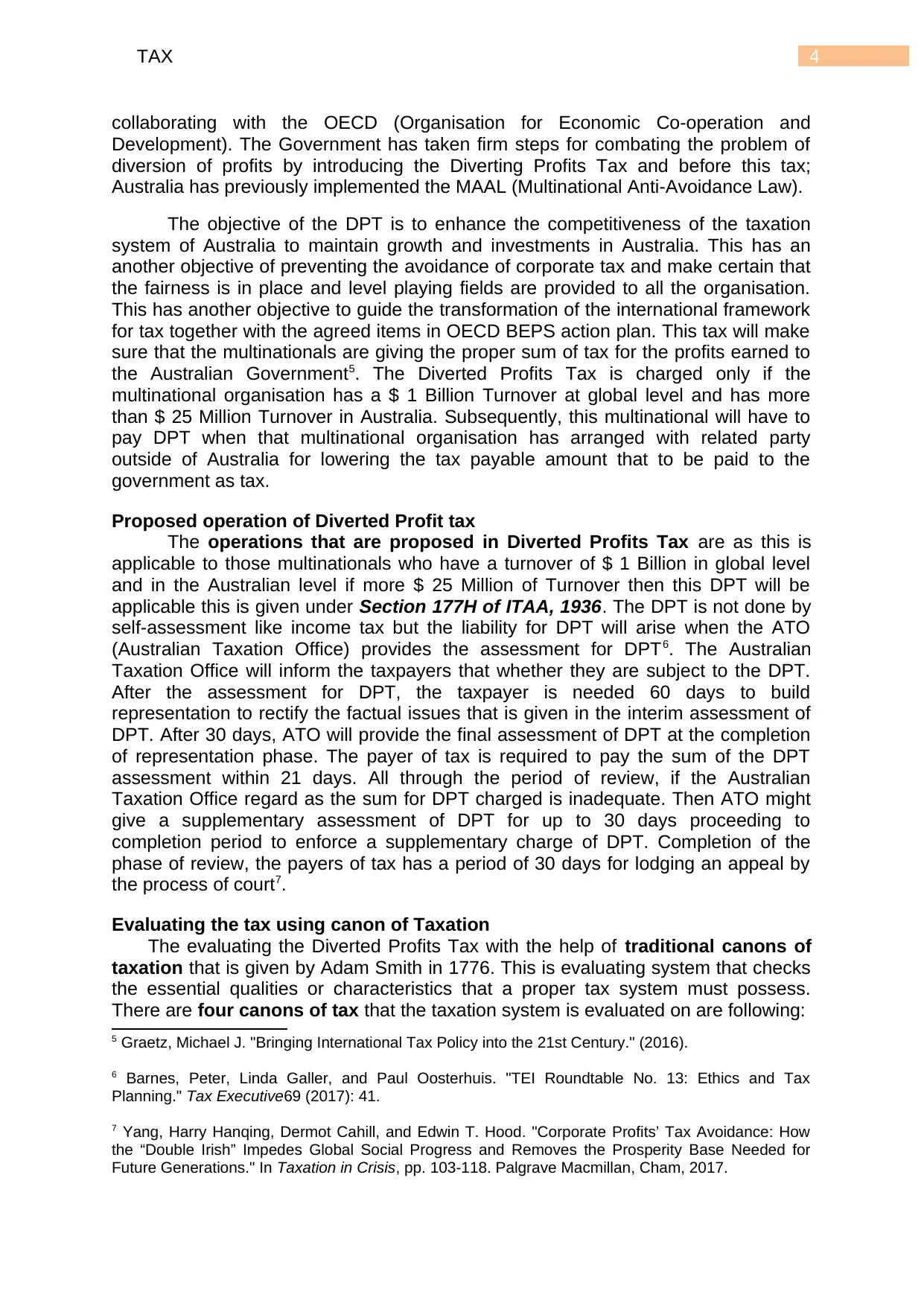
4TAX
collaborating with the OECD (Organisation for Economic Co-operation and
Development). The Government has taken firm steps for combating the problem of
diversion of profits by introducing the Diverting Profits Tax and before this tax;
Australia has previously implemented the MAAL (Multinational Anti-Avoidance Law).
The objective of the DPT is to enhance the competitiveness of the taxation
system of Australia to maintain growth and investments in Australia. This has an
another objective of preventing the avoidance of corporate tax and make certain that
the fairness is in place and level playing fields are provided to all the organisation.
This has another objective to guide the transformation of the international framework
for tax together with the agreed items in OECD BEPS action plan. This tax will make
sure that the multinationals are giving the proper sum of tax for the profits earned to
the Australian Government5. The Diverted Profits Tax is charged only if the
multinational organisation has a $ 1 Billion Turnover at global level and has more
than $ 25 Million Turnover in Australia. Subsequently, this multinational will have to
pay DPT when that multinational organisation has arranged with related party
outside of Australia for lowering the tax payable amount that to be paid to the
government as tax.
Proposed operation of Diverted Profit tax
The operations that are proposed in Diverted Profits Tax are as this is
applicable to those multinationals who have a turnover of $ 1 Billion in global level
and in the Australian level if more $ 25 Million of Turnover then this DPT will be
applicable this is given under Section 177H of ITAA, 1936. The DPT is not done by
self-assessment like income tax but the liability for DPT will arise when the ATO
(Australian Taxation Office) provides the assessment for DPT6. The Australian
Taxation Office will inform the taxpayers that whether they are subject to the DPT.
After the assessment for DPT, the taxpayer is needed 60 days to build
representation to rectify the factual issues that is given in the interim assessment of
DPT. After 30 days, ATO will provide the final assessment of DPT at the completion
of representation phase. The payer of tax is required to pay the sum of the DPT
assessment within 21 days. All through the period of review, if the Australian
Taxation Office regard as the sum for DPT charged is inadequate. Then ATO might
give a supplementary assessment of DPT for up to 30 days proceeding to
completion period to enforce a supplementary charge of DPT. Completion of the
phase of review, the payers of tax has a period of 30 days for lodging an appeal by
the process of court7.
Evaluating the tax using canon of Taxation
The evaluating the Diverted Profits Tax with the help of traditional canons of
taxation that is given by Adam Smith in 1776. This is evaluating system that checks
the essential qualities or characteristics that a proper tax system must possess.
There are four canons of tax that the taxation system is evaluated on are following:
5 Graetz, Michael J. "Bringing International Tax Policy into the 21st Century." (2016).
6 Barnes, Peter, Linda Galler, and Paul Oosterhuis. "TEI Roundtable No. 13: Ethics and Tax
Planning." Tax Executive69 (2017): 41.
7 Yang, Harry Hanqing, Dermot Cahill, and Edwin T. Hood. "Corporate Profits’ Tax Avoidance: How
the “Double Irish” Impedes Global Social Progress and Removes the Prosperity Base Needed for
Future Generations." In Taxation in Crisis, pp. 103-118. Palgrave Macmillan, Cham, 2017.
collaborating with the OECD (Organisation for Economic Co-operation and
Development). The Government has taken firm steps for combating the problem of
diversion of profits by introducing the Diverting Profits Tax and before this tax;
Australia has previously implemented the MAAL (Multinational Anti-Avoidance Law).
The objective of the DPT is to enhance the competitiveness of the taxation
system of Australia to maintain growth and investments in Australia. This has an
another objective of preventing the avoidance of corporate tax and make certain that
the fairness is in place and level playing fields are provided to all the organisation.
This has another objective to guide the transformation of the international framework
for tax together with the agreed items in OECD BEPS action plan. This tax will make
sure that the multinationals are giving the proper sum of tax for the profits earned to
the Australian Government5. The Diverted Profits Tax is charged only if the
multinational organisation has a $ 1 Billion Turnover at global level and has more
than $ 25 Million Turnover in Australia. Subsequently, this multinational will have to
pay DPT when that multinational organisation has arranged with related party
outside of Australia for lowering the tax payable amount that to be paid to the
government as tax.
Proposed operation of Diverted Profit tax
The operations that are proposed in Diverted Profits Tax are as this is
applicable to those multinationals who have a turnover of $ 1 Billion in global level
and in the Australian level if more $ 25 Million of Turnover then this DPT will be
applicable this is given under Section 177H of ITAA, 1936. The DPT is not done by
self-assessment like income tax but the liability for DPT will arise when the ATO
(Australian Taxation Office) provides the assessment for DPT6. The Australian
Taxation Office will inform the taxpayers that whether they are subject to the DPT.
After the assessment for DPT, the taxpayer is needed 60 days to build
representation to rectify the factual issues that is given in the interim assessment of
DPT. After 30 days, ATO will provide the final assessment of DPT at the completion
of representation phase. The payer of tax is required to pay the sum of the DPT
assessment within 21 days. All through the period of review, if the Australian
Taxation Office regard as the sum for DPT charged is inadequate. Then ATO might
give a supplementary assessment of DPT for up to 30 days proceeding to
completion period to enforce a supplementary charge of DPT. Completion of the
phase of review, the payers of tax has a period of 30 days for lodging an appeal by
the process of court7.
Evaluating the tax using canon of Taxation
The evaluating the Diverted Profits Tax with the help of traditional canons of
taxation that is given by Adam Smith in 1776. This is evaluating system that checks
the essential qualities or characteristics that a proper tax system must possess.
There are four canons of tax that the taxation system is evaluated on are following:
5 Graetz, Michael J. "Bringing International Tax Policy into the 21st Century." (2016).
6 Barnes, Peter, Linda Galler, and Paul Oosterhuis. "TEI Roundtable No. 13: Ethics and Tax
Planning." Tax Executive69 (2017): 41.
7 Yang, Harry Hanqing, Dermot Cahill, and Edwin T. Hood. "Corporate Profits’ Tax Avoidance: How
the “Double Irish” Impedes Global Social Progress and Removes the Prosperity Base Needed for
Future Generations." In Taxation in Crisis, pp. 103-118. Palgrave Macmillan, Cham, 2017.
Paraphrase This Document
Need a fresh take? Get an instant paraphrase of this document with our AI Paraphraser
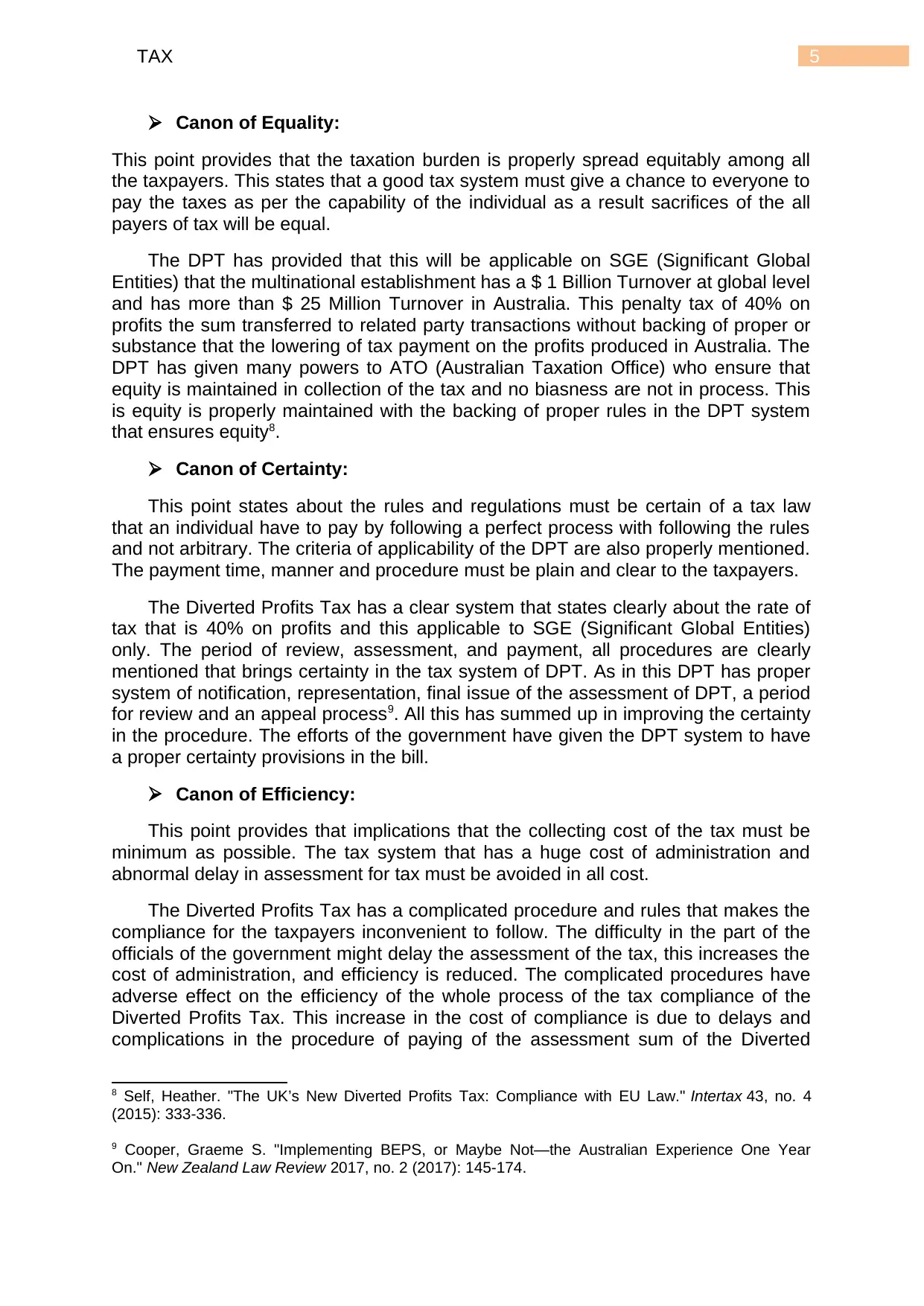
5TAX
Canon of Equality:
This point provides that the taxation burden is properly spread equitably among all
the taxpayers. This states that a good tax system must give a chance to everyone to
pay the taxes as per the capability of the individual as a result sacrifices of the all
payers of tax will be equal.
The DPT has provided that this will be applicable on SGE (Significant Global
Entities) that the multinational establishment has a $ 1 Billion Turnover at global level
and has more than $ 25 Million Turnover in Australia. This penalty tax of 40% on
profits the sum transferred to related party transactions without backing of proper or
substance that the lowering of tax payment on the profits produced in Australia. The
DPT has given many powers to ATO (Australian Taxation Office) who ensure that
equity is maintained in collection of the tax and no biasness are not in process. This
is equity is properly maintained with the backing of proper rules in the DPT system
that ensures equity8.
Canon of Certainty:
This point states about the rules and regulations must be certain of a tax law
that an individual have to pay by following a perfect process with following the rules
and not arbitrary. The criteria of applicability of the DPT are also properly mentioned.
The payment time, manner and procedure must be plain and clear to the taxpayers.
The Diverted Profits Tax has a clear system that states clearly about the rate of
tax that is 40% on profits and this applicable to SGE (Significant Global Entities)
only. The period of review, assessment, and payment, all procedures are clearly
mentioned that brings certainty in the tax system of DPT. As in this DPT has proper
system of notification, representation, final issue of the assessment of DPT, a period
for review and an appeal process9. All this has summed up in improving the certainty
in the procedure. The efforts of the government have given the DPT system to have
a proper certainty provisions in the bill.
Canon of Efficiency:
This point provides that implications that the collecting cost of the tax must be
minimum as possible. The tax system that has a huge cost of administration and
abnormal delay in assessment for tax must be avoided in all cost.
The Diverted Profits Tax has a complicated procedure and rules that makes the
compliance for the taxpayers inconvenient to follow. The difficulty in the part of the
officials of the government might delay the assessment of the tax, this increases the
cost of administration, and efficiency is reduced. The complicated procedures have
adverse effect on the efficiency of the whole process of the tax compliance of the
Diverted Profits Tax. This increase in the cost of compliance is due to delays and
complications in the procedure of paying of the assessment sum of the Diverted
8 Self, Heather. "The UK’s New Diverted Profits Tax: Compliance with EU Law." Intertax 43, no. 4
(2015): 333-336.
9 Cooper, Graeme S. "Implementing BEPS, or Maybe Not—the Australian Experience One Year
On." New Zealand Law Review 2017, no. 2 (2017): 145-174.
Canon of Equality:
This point provides that the taxation burden is properly spread equitably among all
the taxpayers. This states that a good tax system must give a chance to everyone to
pay the taxes as per the capability of the individual as a result sacrifices of the all
payers of tax will be equal.
The DPT has provided that this will be applicable on SGE (Significant Global
Entities) that the multinational establishment has a $ 1 Billion Turnover at global level
and has more than $ 25 Million Turnover in Australia. This penalty tax of 40% on
profits the sum transferred to related party transactions without backing of proper or
substance that the lowering of tax payment on the profits produced in Australia. The
DPT has given many powers to ATO (Australian Taxation Office) who ensure that
equity is maintained in collection of the tax and no biasness are not in process. This
is equity is properly maintained with the backing of proper rules in the DPT system
that ensures equity8.
Canon of Certainty:
This point states about the rules and regulations must be certain of a tax law
that an individual have to pay by following a perfect process with following the rules
and not arbitrary. The criteria of applicability of the DPT are also properly mentioned.
The payment time, manner and procedure must be plain and clear to the taxpayers.
The Diverted Profits Tax has a clear system that states clearly about the rate of
tax that is 40% on profits and this applicable to SGE (Significant Global Entities)
only. The period of review, assessment, and payment, all procedures are clearly
mentioned that brings certainty in the tax system of DPT. As in this DPT has proper
system of notification, representation, final issue of the assessment of DPT, a period
for review and an appeal process9. All this has summed up in improving the certainty
in the procedure. The efforts of the government have given the DPT system to have
a proper certainty provisions in the bill.
Canon of Efficiency:
This point provides that implications that the collecting cost of the tax must be
minimum as possible. The tax system that has a huge cost of administration and
abnormal delay in assessment for tax must be avoided in all cost.
The Diverted Profits Tax has a complicated procedure and rules that makes the
compliance for the taxpayers inconvenient to follow. The difficulty in the part of the
officials of the government might delay the assessment of the tax, this increases the
cost of administration, and efficiency is reduced. The complicated procedures have
adverse effect on the efficiency of the whole process of the tax compliance of the
Diverted Profits Tax. This increase in the cost of compliance is due to delays and
complications in the procedure of paying of the assessment sum of the Diverted
8 Self, Heather. "The UK’s New Diverted Profits Tax: Compliance with EU Law." Intertax 43, no. 4
(2015): 333-336.
9 Cooper, Graeme S. "Implementing BEPS, or Maybe Not—the Australian Experience One Year
On." New Zealand Law Review 2017, no. 2 (2017): 145-174.
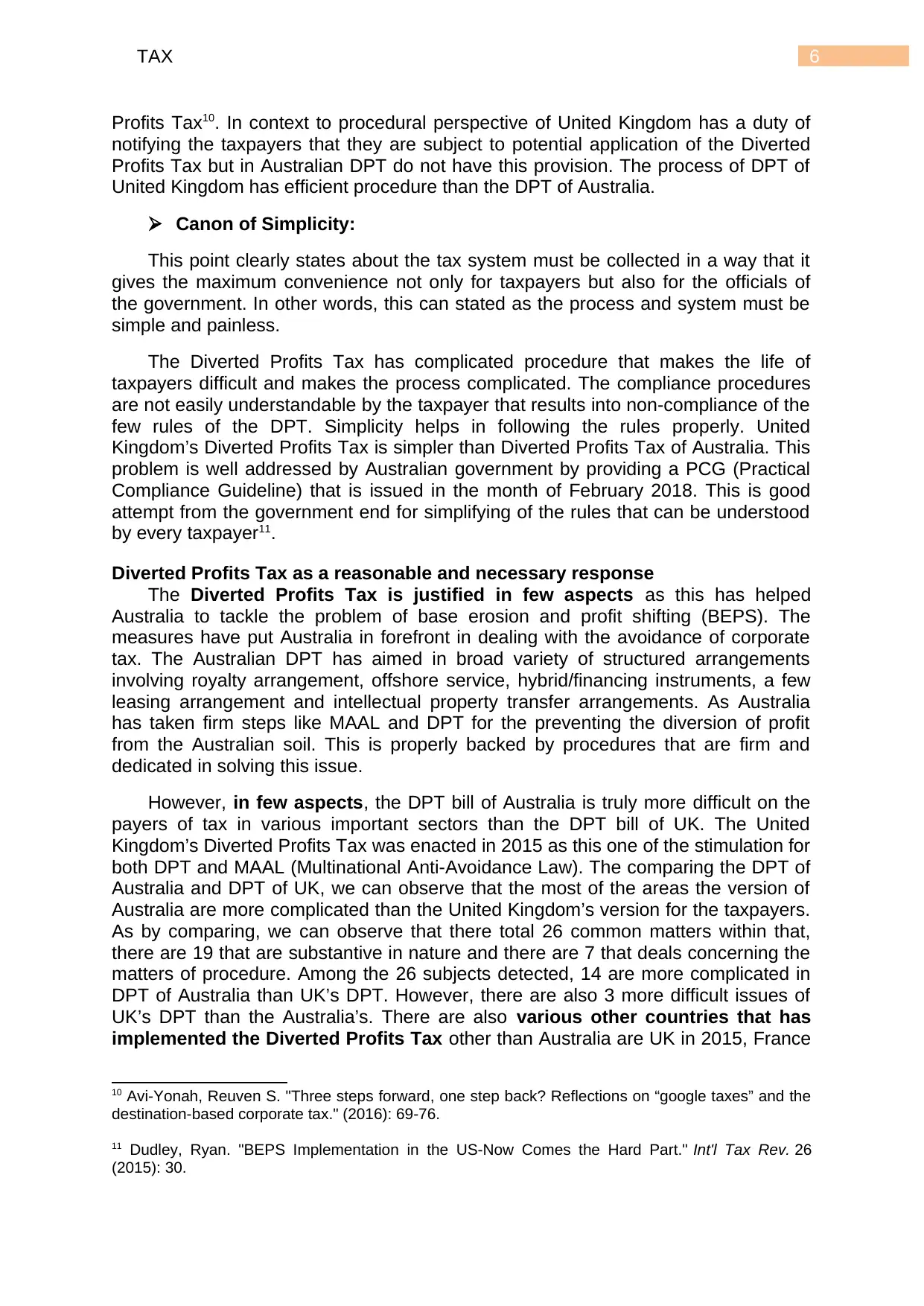
6TAX
Profits Tax10. In context to procedural perspective of United Kingdom has a duty of
notifying the taxpayers that they are subject to potential application of the Diverted
Profits Tax but in Australian DPT do not have this provision. The process of DPT of
United Kingdom has efficient procedure than the DPT of Australia.
Canon of Simplicity:
This point clearly states about the tax system must be collected in a way that it
gives the maximum convenience not only for taxpayers but also for the officials of
the government. In other words, this can stated as the process and system must be
simple and painless.
The Diverted Profits Tax has complicated procedure that makes the life of
taxpayers difficult and makes the process complicated. The compliance procedures
are not easily understandable by the taxpayer that results into non-compliance of the
few rules of the DPT. Simplicity helps in following the rules properly. United
Kingdom’s Diverted Profits Tax is simpler than Diverted Profits Tax of Australia. This
problem is well addressed by Australian government by providing a PCG (Practical
Compliance Guideline) that is issued in the month of February 2018. This is good
attempt from the government end for simplifying of the rules that can be understood
by every taxpayer11.
Diverted Profits Tax as a reasonable and necessary response
The Diverted Profits Tax is justified in few aspects as this has helped
Australia to tackle the problem of base erosion and profit shifting (BEPS). The
measures have put Australia in forefront in dealing with the avoidance of corporate
tax. The Australian DPT has aimed in broad variety of structured arrangements
involving royalty arrangement, offshore service, hybrid/financing instruments, a few
leasing arrangement and intellectual property transfer arrangements. As Australia
has taken firm steps like MAAL and DPT for the preventing the diversion of profit
from the Australian soil. This is properly backed by procedures that are firm and
dedicated in solving this issue.
However, in few aspects, the DPT bill of Australia is truly more difficult on the
payers of tax in various important sectors than the DPT bill of UK. The United
Kingdom’s Diverted Profits Tax was enacted in 2015 as this one of the stimulation for
both DPT and MAAL (Multinational Anti-Avoidance Law). The comparing the DPT of
Australia and DPT of UK, we can observe that the most of the areas the version of
Australia are more complicated than the United Kingdom’s version for the taxpayers.
As by comparing, we can observe that there total 26 common matters within that,
there are 19 that are substantive in nature and there are 7 that deals concerning the
matters of procedure. Among the 26 subjects detected, 14 are more complicated in
DPT of Australia than UK’s DPT. However, there are also 3 more difficult issues of
UK’s DPT than the Australia’s. There are also various other countries that has
implemented the Diverted Profits Tax other than Australia are UK in 2015, France
10 Avi-Yonah, Reuven S. "Three steps forward, one step back? Reflections on “google taxes” and the
destination-based corporate tax." (2016): 69-76.
11 Dudley, Ryan. "BEPS Implementation in the US-Now Comes the Hard Part." Int'l Tax Rev. 26
(2015): 30.
Profits Tax10. In context to procedural perspective of United Kingdom has a duty of
notifying the taxpayers that they are subject to potential application of the Diverted
Profits Tax but in Australian DPT do not have this provision. The process of DPT of
United Kingdom has efficient procedure than the DPT of Australia.
Canon of Simplicity:
This point clearly states about the tax system must be collected in a way that it
gives the maximum convenience not only for taxpayers but also for the officials of
the government. In other words, this can stated as the process and system must be
simple and painless.
The Diverted Profits Tax has complicated procedure that makes the life of
taxpayers difficult and makes the process complicated. The compliance procedures
are not easily understandable by the taxpayer that results into non-compliance of the
few rules of the DPT. Simplicity helps in following the rules properly. United
Kingdom’s Diverted Profits Tax is simpler than Diverted Profits Tax of Australia. This
problem is well addressed by Australian government by providing a PCG (Practical
Compliance Guideline) that is issued in the month of February 2018. This is good
attempt from the government end for simplifying of the rules that can be understood
by every taxpayer11.
Diverted Profits Tax as a reasonable and necessary response
The Diverted Profits Tax is justified in few aspects as this has helped
Australia to tackle the problem of base erosion and profit shifting (BEPS). The
measures have put Australia in forefront in dealing with the avoidance of corporate
tax. The Australian DPT has aimed in broad variety of structured arrangements
involving royalty arrangement, offshore service, hybrid/financing instruments, a few
leasing arrangement and intellectual property transfer arrangements. As Australia
has taken firm steps like MAAL and DPT for the preventing the diversion of profit
from the Australian soil. This is properly backed by procedures that are firm and
dedicated in solving this issue.
However, in few aspects, the DPT bill of Australia is truly more difficult on the
payers of tax in various important sectors than the DPT bill of UK. The United
Kingdom’s Diverted Profits Tax was enacted in 2015 as this one of the stimulation for
both DPT and MAAL (Multinational Anti-Avoidance Law). The comparing the DPT of
Australia and DPT of UK, we can observe that the most of the areas the version of
Australia are more complicated than the United Kingdom’s version for the taxpayers.
As by comparing, we can observe that there total 26 common matters within that,
there are 19 that are substantive in nature and there are 7 that deals concerning the
matters of procedure. Among the 26 subjects detected, 14 are more complicated in
DPT of Australia than UK’s DPT. However, there are also 3 more difficult issues of
UK’s DPT than the Australia’s. There are also various other countries that has
implemented the Diverted Profits Tax other than Australia are UK in 2015, France
10 Avi-Yonah, Reuven S. "Three steps forward, one step back? Reflections on “google taxes” and the
destination-based corporate tax." (2016): 69-76.
11 Dudley, Ryan. "BEPS Implementation in the US-Now Comes the Hard Part." Int'l Tax Rev. 26
(2015): 30.
⊘ This is a preview!⊘
Do you want full access?
Subscribe today to unlock all pages.

Trusted by 1+ million students worldwide
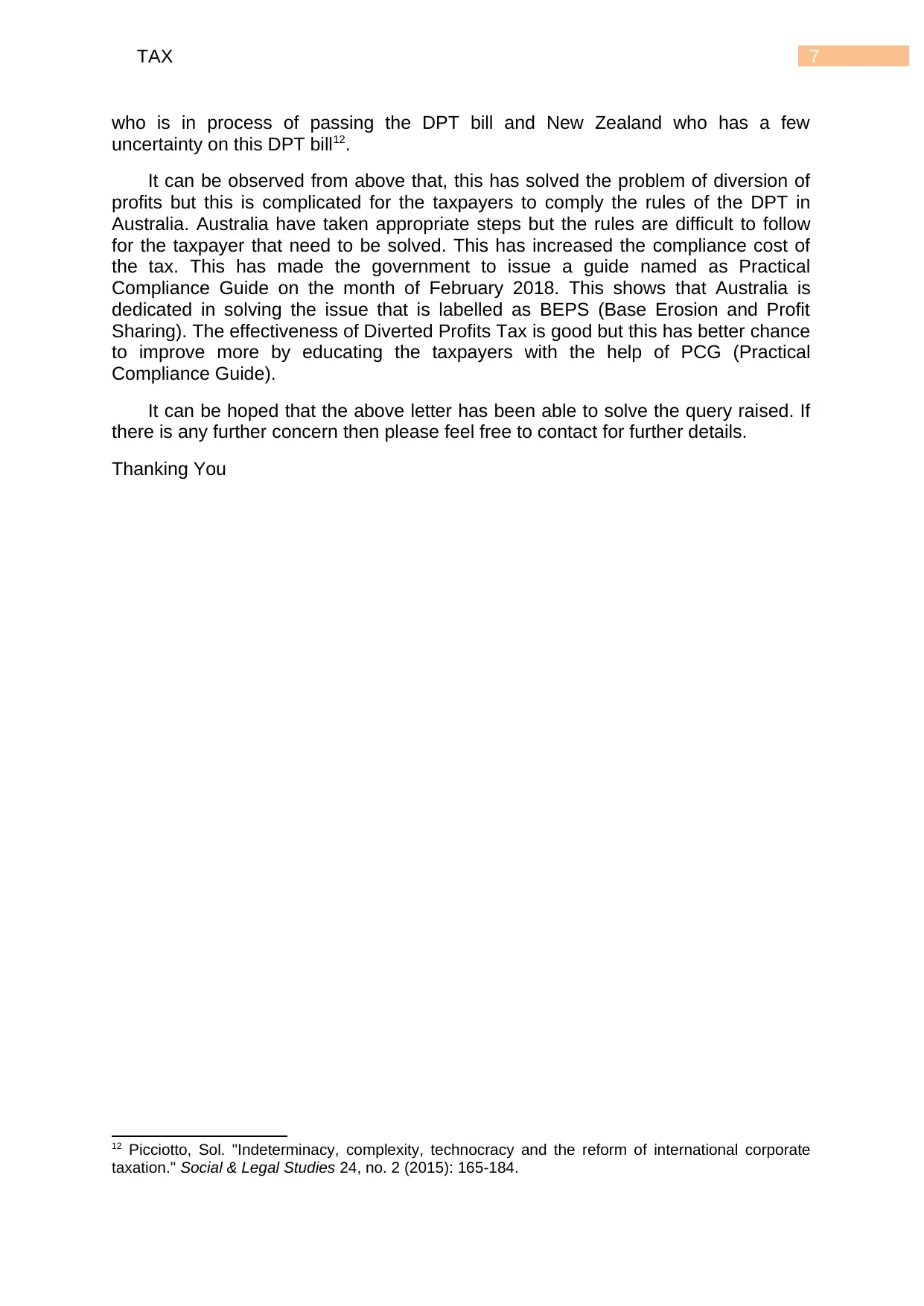
7TAX
who is in process of passing the DPT bill and New Zealand who has a few
uncertainty on this DPT bill12.
It can be observed from above that, this has solved the problem of diversion of
profits but this is complicated for the taxpayers to comply the rules of the DPT in
Australia. Australia have taken appropriate steps but the rules are difficult to follow
for the taxpayer that need to be solved. This has increased the compliance cost of
the tax. This has made the government to issue a guide named as Practical
Compliance Guide on the month of February 2018. This shows that Australia is
dedicated in solving the issue that is labelled as BEPS (Base Erosion and Profit
Sharing). The effectiveness of Diverted Profits Tax is good but this has better chance
to improve more by educating the taxpayers with the help of PCG (Practical
Compliance Guide).
It can be hoped that the above letter has been able to solve the query raised. If
there is any further concern then please feel free to contact for further details.
Thanking You
12 Picciotto, Sol. "Indeterminacy, complexity, technocracy and the reform of international corporate
taxation." Social & Legal Studies 24, no. 2 (2015): 165-184.
who is in process of passing the DPT bill and New Zealand who has a few
uncertainty on this DPT bill12.
It can be observed from above that, this has solved the problem of diversion of
profits but this is complicated for the taxpayers to comply the rules of the DPT in
Australia. Australia have taken appropriate steps but the rules are difficult to follow
for the taxpayer that need to be solved. This has increased the compliance cost of
the tax. This has made the government to issue a guide named as Practical
Compliance Guide on the month of February 2018. This shows that Australia is
dedicated in solving the issue that is labelled as BEPS (Base Erosion and Profit
Sharing). The effectiveness of Diverted Profits Tax is good but this has better chance
to improve more by educating the taxpayers with the help of PCG (Practical
Compliance Guide).
It can be hoped that the above letter has been able to solve the query raised. If
there is any further concern then please feel free to contact for further details.
Thanking You
12 Picciotto, Sol. "Indeterminacy, complexity, technocracy and the reform of international corporate
taxation." Social & Legal Studies 24, no. 2 (2015): 165-184.
Paraphrase This Document
Need a fresh take? Get an instant paraphrase of this document with our AI Paraphraser
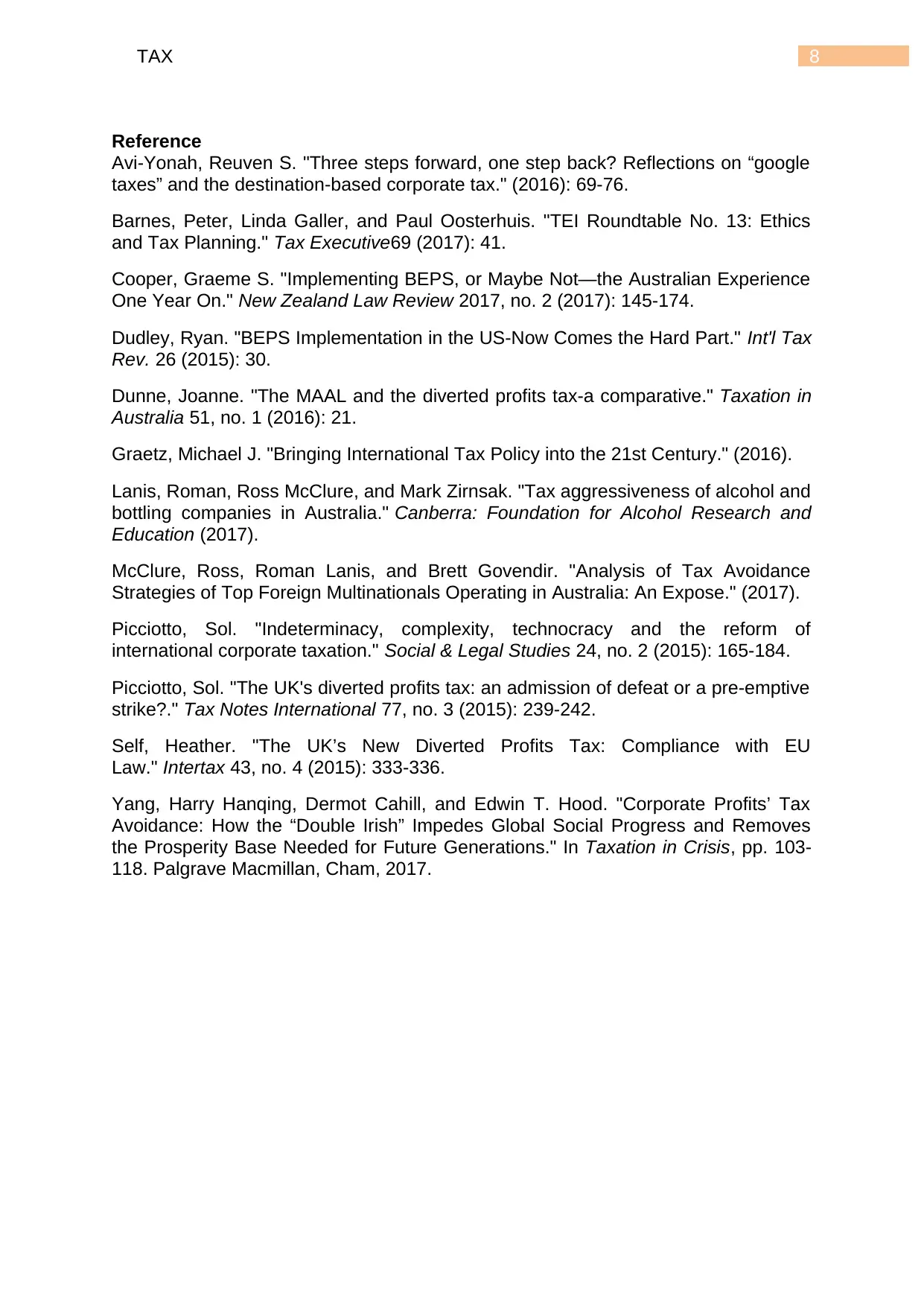
8TAX
Reference
Avi-Yonah, Reuven S. "Three steps forward, one step back? Reflections on “google
taxes” and the destination-based corporate tax." (2016): 69-76.
Barnes, Peter, Linda Galler, and Paul Oosterhuis. "TEI Roundtable No. 13: Ethics
and Tax Planning." Tax Executive69 (2017): 41.
Cooper, Graeme S. "Implementing BEPS, or Maybe Not—the Australian Experience
One Year On." New Zealand Law Review 2017, no. 2 (2017): 145-174.
Dudley, Ryan. "BEPS Implementation in the US-Now Comes the Hard Part." Int'l Tax
Rev. 26 (2015): 30.
Dunne, Joanne. "The MAAL and the diverted profits tax-a comparative." Taxation in
Australia 51, no. 1 (2016): 21.
Graetz, Michael J. "Bringing International Tax Policy into the 21st Century." (2016).
Lanis, Roman, Ross McClure, and Mark Zirnsak. "Tax aggressiveness of alcohol and
bottling companies in Australia." Canberra: Foundation for Alcohol Research and
Education (2017).
McClure, Ross, Roman Lanis, and Brett Govendir. "Analysis of Tax Avoidance
Strategies of Top Foreign Multinationals Operating in Australia: An Expose." (2017).
Picciotto, Sol. "Indeterminacy, complexity, technocracy and the reform of
international corporate taxation." Social & Legal Studies 24, no. 2 (2015): 165-184.
Picciotto, Sol. "The UK's diverted profits tax: an admission of defeat or a pre-emptive
strike?." Tax Notes International 77, no. 3 (2015): 239-242.
Self, Heather. "The UK’s New Diverted Profits Tax: Compliance with EU
Law." Intertax 43, no. 4 (2015): 333-336.
Yang, Harry Hanqing, Dermot Cahill, and Edwin T. Hood. "Corporate Profits’ Tax
Avoidance: How the “Double Irish” Impedes Global Social Progress and Removes
the Prosperity Base Needed for Future Generations." In Taxation in Crisis, pp. 103-
118. Palgrave Macmillan, Cham, 2017.
Reference
Avi-Yonah, Reuven S. "Three steps forward, one step back? Reflections on “google
taxes” and the destination-based corporate tax." (2016): 69-76.
Barnes, Peter, Linda Galler, and Paul Oosterhuis. "TEI Roundtable No. 13: Ethics
and Tax Planning." Tax Executive69 (2017): 41.
Cooper, Graeme S. "Implementing BEPS, or Maybe Not—the Australian Experience
One Year On." New Zealand Law Review 2017, no. 2 (2017): 145-174.
Dudley, Ryan. "BEPS Implementation in the US-Now Comes the Hard Part." Int'l Tax
Rev. 26 (2015): 30.
Dunne, Joanne. "The MAAL and the diverted profits tax-a comparative." Taxation in
Australia 51, no. 1 (2016): 21.
Graetz, Michael J. "Bringing International Tax Policy into the 21st Century." (2016).
Lanis, Roman, Ross McClure, and Mark Zirnsak. "Tax aggressiveness of alcohol and
bottling companies in Australia." Canberra: Foundation for Alcohol Research and
Education (2017).
McClure, Ross, Roman Lanis, and Brett Govendir. "Analysis of Tax Avoidance
Strategies of Top Foreign Multinationals Operating in Australia: An Expose." (2017).
Picciotto, Sol. "Indeterminacy, complexity, technocracy and the reform of
international corporate taxation." Social & Legal Studies 24, no. 2 (2015): 165-184.
Picciotto, Sol. "The UK's diverted profits tax: an admission of defeat or a pre-emptive
strike?." Tax Notes International 77, no. 3 (2015): 239-242.
Self, Heather. "The UK’s New Diverted Profits Tax: Compliance with EU
Law." Intertax 43, no. 4 (2015): 333-336.
Yang, Harry Hanqing, Dermot Cahill, and Edwin T. Hood. "Corporate Profits’ Tax
Avoidance: How the “Double Irish” Impedes Global Social Progress and Removes
the Prosperity Base Needed for Future Generations." In Taxation in Crisis, pp. 103-
118. Palgrave Macmillan, Cham, 2017.
1 out of 8
Your All-in-One AI-Powered Toolkit for Academic Success.
+13062052269
info@desklib.com
Available 24*7 on WhatsApp / Email
![[object Object]](/_next/static/media/star-bottom.7253800d.svg)
Unlock your academic potential
Copyright © 2020–2025 A2Z Services. All Rights Reserved. Developed and managed by ZUCOL.
